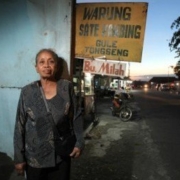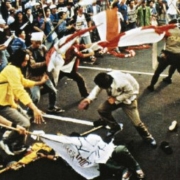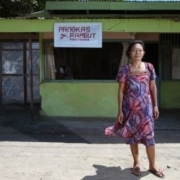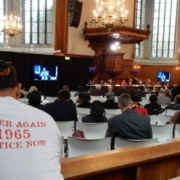
Joshua Oppenheimer at the University of Melbourne on 11 August.
Joshua Oppenheimer is in Melbourne, where The Look of Silence, his stunning follow-up to The Act of Killing, is screening at the Melbourne International Film Festival. While The Act of Killing provided a surreal and morbid stage for the perpetrators of the 1965-1966 genocide to re-enact the violence, The Look of Silence focuses sharply on the survivors. The subject of the second film is Adi Rukun, an optometrist whose older brother, Ramli, was murdered during the violence, before Adi was born. In the film, we join Adi as he tests the vision of perpetrators, questioning and confronting them about their roles in his brother’s death. On 11 August, Oppenheimer spoke to Jason Di Rosso, from ABC Radio National, at the University of Melbourne, and then to Indonesia at Melbourne after the event.
One of the criticisms you faced for The Act of Killing was the limited broader discussion of the role of the Indonesian military, or the Cold War context at the time. Is this something that you were conscious of when you were making The Look of Silence?
I read the criticism, of course, that context was lacking in the first film, and people have said it about the second film, too. First of all, these two films are about today, they are about lived experience today. I didn’t make an effort to provide historical context in either film because what does it mean to provide historical context in a film? It would stop immersing you in the present and – more disruptive still – it would mean providing you with a narrator with sufficient distance to be able to present you with a historical narrative. This would pull you out of the immersive experience of being with Anwar [Congo, the main perpetrator featured in The Act of Killing] and his friends in this unfolding fever dream, or being immersed in this haunted space with Adi and his family. The moment you are having events explained to you, you are no longer identifying with Adi, or with Anwar, or with Rohani (Adi’s mother). You will be identifying with the person who is explaining the past. So I have talked a great deal about whatever history I can over the last three years presenting these films. There have been historical films made about this. For example, there was a film called Shadow Play, by an Australian filmmaker. That’s not the kind of film I felt I needed to make. One thing that is certain is that the film has triggered national and international discussion about what happened that wouldn’t have been triggered if the films were less impactful. And I realise that the films would be less impactful if I broke the experience of being immersed to tell a historical narrative.
Adi is a remarkable interviewer.
I hesitate to say that it is an interview at all. An interview is when you are trying to find out information. Adi knows what these men have done. He is trying to achieve something through these conversations. He is trying to get them to acknowledge what he believes they already know, which is that it is wrong, and he does this by looking at them with this humanising gaze, with this unflinching and gentle, but also honest, gaze. He is saying: “You are human. If you just admit what you have done is wrong, then I can separate your humanity from your crime and I can forgive you as a human being.” You would think that this would make it easier for them, because they have forgiveness within their reach. But it doesn’t. I think it makes it much harder. Because they have to look back at Adi’s face and they are forced to see him as human, they are forced to see Ramli as a human being and by extension all of their victims as human beings. In this mirror, in which they see their own humanity, they confront their conscience, and they panic. They are not afraid of him, they are afraid of their own guilt. Adi is focused single-mindedly on achieving this confrontation, so of course he asks the most confronting and pertinent questions. And he is a brilliant man.
The scene with Adi’s father crawling on the floor was difficult to watch. Can you describe how this scene came about?
This is the one scene in The Look of Silence that Adi shot. [When he showed me the footage] Adi said: “This is the first day my father couldn’t remember anyone in our family. He was confused and calling for help all day and we couldn’t help him even though we tried. He’s nearly deaf, nearly blind, and we would have to touch him, to let him know we were there, then he would panic, thinking that we were strangers coming for him.” Adi said it was unbearable to have his father at home in the house, and to not be able to help him. At some point, not knowing what else to do, he picked up the camera to film, sort of to protect himself from what was happening. Adi said the moment he started filming he realised he was documenting the day it became too late for his father to heal. Because he couldn’t remember the son whose murder destroyed the family, destroyed his life, but he hadn’t forgotten the fear. He could never work through the fear because he couldn’t remember what happened. Adi realised his father would die in this prison of fear, like a man locked in a room who can’t even find the door, let alone the key. So he watched this scene play out and at the end he looked at me and he said, “You see I don’t want my children to inherit this prison of fear from my father, and from my mother and me.”
There was a scene in the middle of the film where Adi’s wife reveals that she did not know what Adi has been doing and she says that she fears for his safety.
When this scene comes in the film, you have already seen Adi threatened a couple of times. And that is important so that you can feel the risk that his wife is responding to, that she understands. But in reality we shot one confrontation first. We chose one confrontation that we could shoot at really low risk to anybody, and that was the confrontation with Inong, the man in the red glasses in the opening of the film. Inong was very low ranking, he lived in a remote location, and we knew that he had such an arrogant personality that all of his superiors hated him and saw him as a liar. So we knew it was unlikely that he would have anyone to complain to afterwards. Adi doesn’t reveal himself, he just confronts Inong on the lies that he is telling to justify what he has done. We then went back and screened this footage to Adi’s mother and wife and said: “This is what these confrontations look like; this is what Adi is trying to do.” They were very moved. Suddenly they saw this gulf of silence was being bridged.
What measures did you take to protect the family during filming and since the film has screened?
After Adi’s family agreed we started planning for how to do it safely, which included having the family at the airport ready to evacuate if anything went wrong. We had a getaway car for Adi so the moment we were done shooting he was bundled out in a car. We made sure Adi carried no ID so that if he were detained they couldn’t figure out who he was by the time we got help from our embassies. We also agreed that we would not release the film until we made a comprehensive plan that the family was comfortable with.
There is now a team of five people working full-time to monitor the family’s safety. It was almost harder to raise money to support the safe release of the film than it was to raise money to make the film. Maybe it was harder. Another 20 people in different capacities are working on a voluntary basis monitoring threats. They haven’t been threatened – Adi hasn’t received a single threat. That is in part because he hasn’t offended people who are quite as powerful and he hasn’t returned to North Sumatra. We have raised money for Adi to open a brick and mortar optometry store, and I hope that will be safe, I hope that it won’t be a target. I don’t think it will. We’ve raised money for the children to be in better schools and for them to get whatever university education they want. All of them keep a current Danish visa and an invitation to come to Denmark for as long as necessary with resources to support them for the first couple of years if anything goes wrong. But nothing has gone wrong. [This precaution] was in place for six months before the film had its first screening at the Venice Film Festival.
I have spoken with Indonesians who took issue with the scenes that showed perpetrators describing how they would drink the blood of their victims. Their view was that there was already enough shockingly violent detail, and such detail furthered notions that Indonesians were irrational and did not value life, that they were literally bloodthirsty. Can you describe your decision-making process in including such graphic descriptions of violence?
In general, I included as little as possible. Most viewers of The Look of Silence have not seen The Act of Killing. They need to take in the boastful way that the perpetrators are talking about the grisly details of atrocities in order to understand it as defensive. I am actually a very squeamish person. Every time I hear about the drinking blood I almost faint. I remember one time when we were shooting I had to hand my camera over to my Indonesian crew member and almost vomit. It was horrible. But it is always there because of the effect it is having in the present, in the moment of its recount. It is there twice. It is there when Inong tells it to Adi and it is the first time Adi is taking in the moral blindness of the perpetrators. If I could have established that without including the drinking blood I would have. The second time it comes is when Syamsir describes it in front of his daughter and it leads her to realise that her father is not the hero she thought he was. If he had talked about something else, I would have preferred that, but that’s what he talked about.
I also think you need to take Indonesian reactions outside of Indonesia with a pinch of salt. The vast majority of Indonesian viewers of my films are inside Indonesia and they don’t watch them with the peculiar self-consciousness that comes from being abroad and from a country that is relatively misunderstood and unknown. Of course there is understandably a sense of: “How does this make my country look, how does this make my people look?” But you don’t have that in a screening when everyone is Indonesian, inside Indonesia. When Indonesians approach me after my films and say that it made them embarrassed to watch the film surrounded by non-Indonesians I say: “I am sorry for that and I fully understand that. I hope, however, you understand that the film is impactful because people everywhere in the world are not seeing the film as a window on to Indonesia, and as a kind of description of what Indonesians are like, but actually as a mirror in which we see ourselves.” Only those viewers who have closed themselves to the moral meaning of this film are thinking about what these films say about Indonesians per se.
You have spoken about how although the films have reached a broad audience, discussion of the films is largely limited to the intellectual community and activists. Do you think broader reach is necessary for the process of reconciliation?
One good thing about not relying on commercial cinema distribution is that we are able to have screenings in remote villages. Everywhere that an NGO that supports the film has activities they hold screenings. I think the film has probably had a wider reach than I know. Honestly, the discussion among the middle class is really important in terms of defining the national conversation. Something that is rarely talked about with The Look of Silence, but important, is that it is unusual to have a film about a family where everybody apart from Adi is illiterate. Where no one went to school, where there is no NGO that brought me to them, where there was no access to a kind of outside world until Adi met me. I think it is important to show that. Part of the impact of the film in Indonesia is because Indonesians are seeing not an elite family, not an educated family, not a family of former leaders, but they are seeing one of millions of families that are all over the country and they know that. So I think part of the reaction is “Is this what we’ve done? Is this the suffering that millions of our countrymen are enduring every day?”
Listen to the full discussion between Jason Di Russo and Joshua Oppenheimer on the ABC website. Read Jess Melvin’s review of The Look of Silence for Indonesia at Melbourne here.











